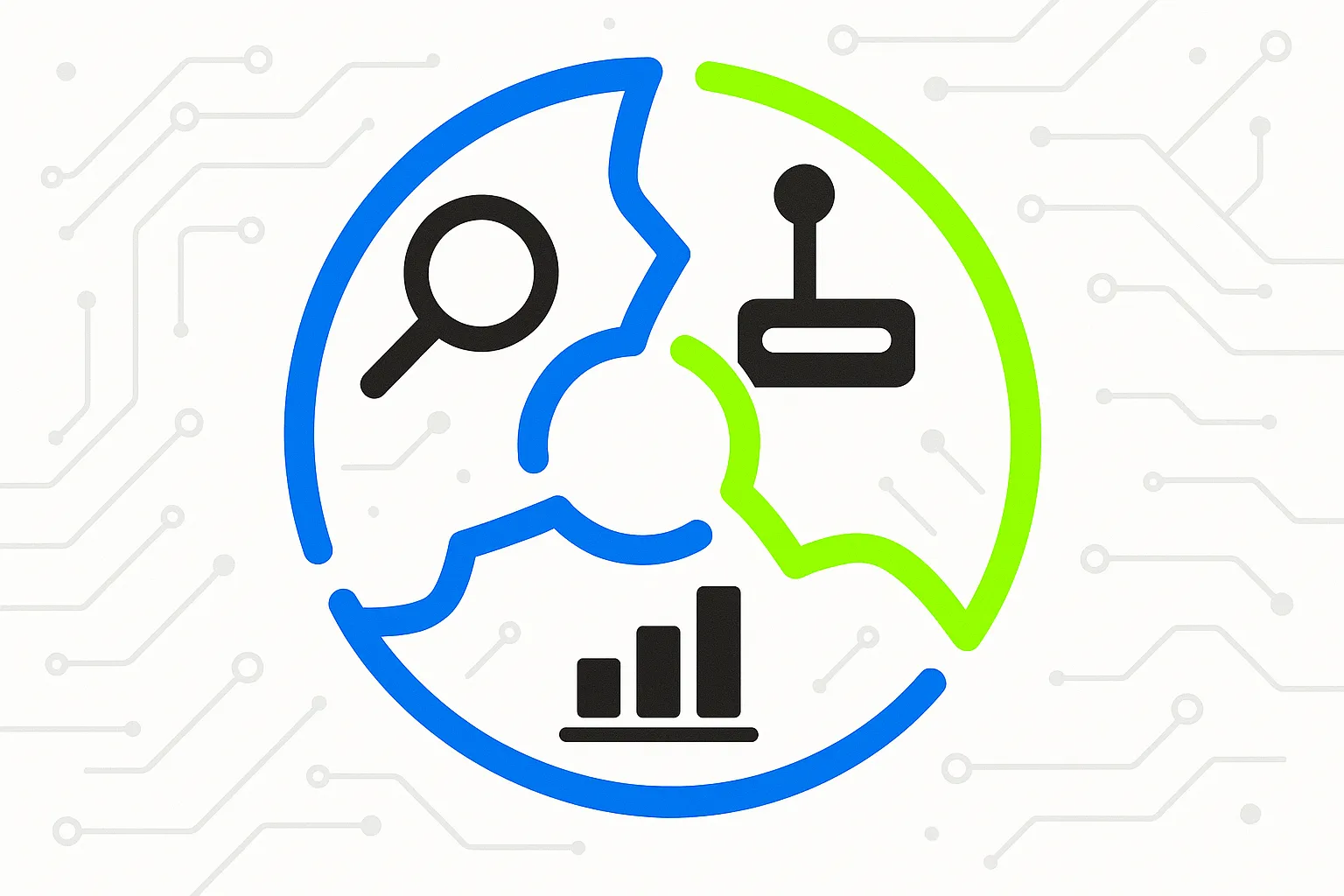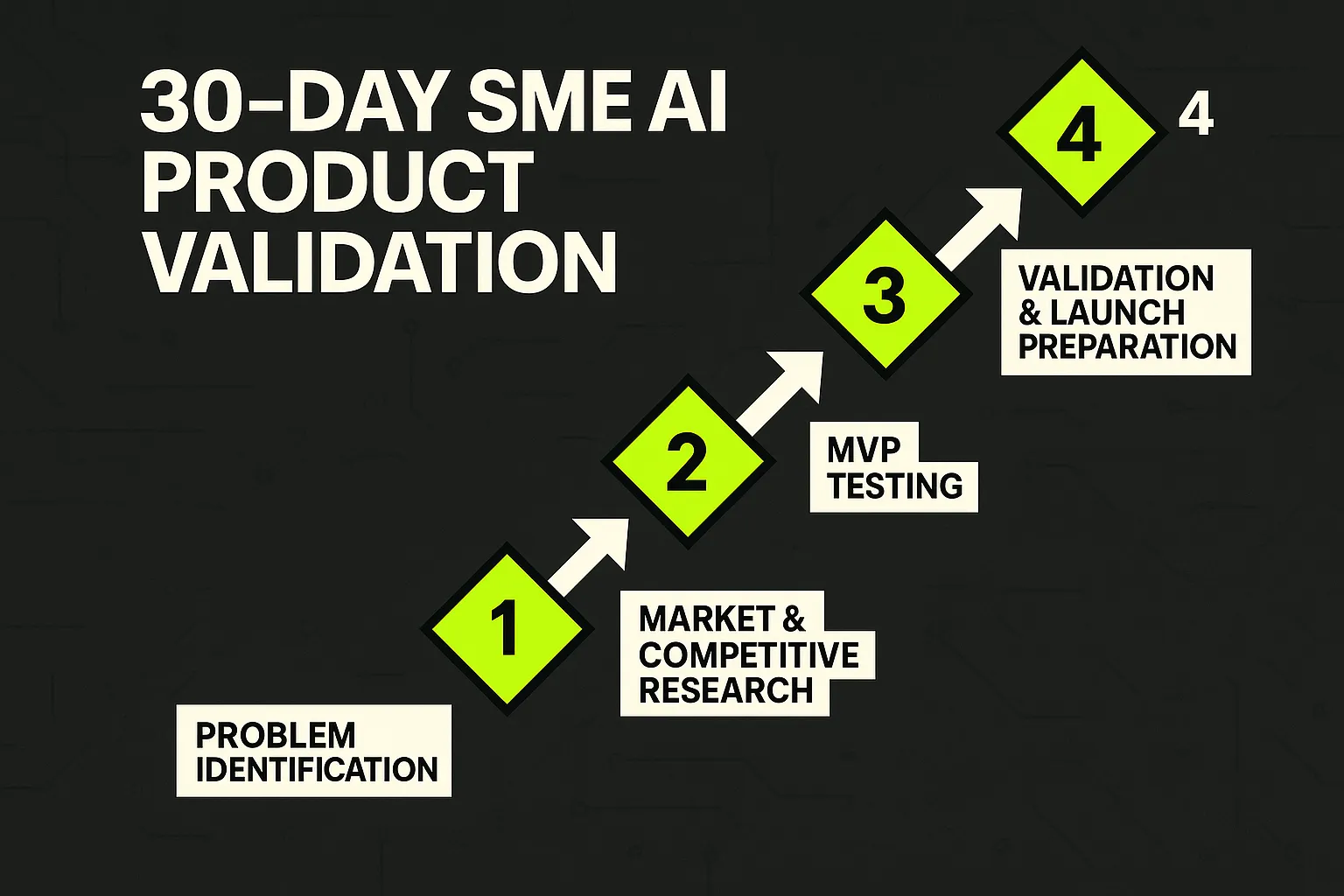Beyond the Hype: A Practical Framework for AI Product Ideation
AI Summary
The article on Beyond the Hype: A Practical Framework for AI Product Ideation offers SME owners and decision-makers a strategic approach to discover, validate, and develop AI product opportunities tailored to their unique business challenges and constraints. It transforms generic AI hype into actionable, evidence-based steps designed to reduce risk and maximize market fit.
- Who: Small and medium-sized business owners, operators, and strategists seeking AI solutions.
- What: A structured four-step opportunity mapping framework plus validation toolkit for AI products.
- When: Immediate application recommended with a 30-day validation plan.
- Where: SMEs across industries aiming to leverage AI for operational efficiency and market growth.
- Why: To confidently identify AI opportunities that mirror real customer pain points, optimize costs, and create defensible competitive advantages through evidence-based validation.
This comprehensive guide moves beyond basic AI idea lists, addressing the real practicalities of ideation, fit, implementation, and testing—empowering SMEs to act with clear focus, agility, and measurable impact.
You've seen the headlines and the endless lists of "AI business ideas." They promise a revolution but offer little more than a paragraph of inspiration. For a small or medium-sized business, these lists create more noise than clarity. They tell you what AI can do, but they completely ignore the crucial question: how do you find and validate an AI opportunity that fits your business, your customers, and your budget?
The reality is, SMEs have a distinct advantage in the AI race. Your agility allows you to pivot quickly, and your direct connection to customers provides the exact insights needed to build solutions people actually want. Research shows that 77% of small businesses have already adopted AI, with 91% reporting a direct boost in revenue. The opportunity is real. You just need a system to uncover it.
This guide provides that system. We will move past the superficial lists and give you a repeatable framework for identifying, mapping, and de-risking AI product ideas. This is not about chasing trends. It's about building a strategic, defensible product that solves a real-world problem.
Part 1: The Mindset Shift: From "What AI Can Do" to "What I Can Solve with AI"
The biggest mistake SMEs make is starting with the technology. They see a cool AI tool and try to force it into their business model. High-authority sources like MIT Sloan offer conceptual frameworks, but they are often too abstract for a hands-on business owner. The most effective approach is the opposite. Start with a problem.
Your goal is to shift your thinking from a technology-first mindset to a problem-first one. Instead of asking, "What can I build with generative AI?" ask, "What is the most inefficient, frustrating, or costly process my customers or my team endure, and how could intelligence automate or eliminate it?"
This simple change in perspective is powerful. It grounds your ideation process in tangible value, ensuring that whatever you build has a built-in audience waiting for a solution. It is the first step toward building a product that doesn't just work, but one that customers are willing to pay for. This focus on systems and efficiency is at the core of the pageBody AI philosophy.
Part 2: The Opportunity Mapping Framework: A 4-Step Process for Finding Your Niche
Once you adopt a problem-first mindset, you need a structured way to uncover opportunities. Generic listicles fail because they lack a methodology. Here is a practical, four-step framework designed specifically for the resourcefulness of SMEs.

A clear 4-step framework that simplifies complex AI opportunity mapping, helping SMEs efficiently evaluate niche ideas and make informed strategic choices.
Step 1: Identify High-Friction Processes
Start by looking for bottlenecks, both internally and for your customers. Where do people get stuck? What tasks consume the most time for the least valuable output?
- Internal Operations: Map out your core workflows. Is your sales team spending hours manually writing follow-up emails? Does your support team answer the same ten questions repeatedly?
- Customer Journey: Where do customers drop off? What part of using your product or service causes the most confusion or requires the most support?
These friction points are goldmines for AI opportunities. AI-driven automation can lead to an average operational cost reduction of 25% for SMEs, making this a powerful place to start.
Step 2: Analyze Unstructured Data
Your business is sitting on a wealth of unstructured data. This includes customer reviews, support tickets, social media comments, and forum discussions. Unlike your larger competitors, you can analyze this data with a human touch to find patterns.
- Look for recurring complaints: Are customers consistently confused about a specific feature?
- Identify desired outcomes: What are customers trying to achieve that your current solution only partially helps with?
- Listen to their language: The words customers use reveal their pain points and priorities in a way that quantitative data never can.
Step 3: Map Problems to AI Capabilities
With a clear list of problems, you can now begin to connect them to specific AI solutions. You don't need a PhD in machine learning for this. Just a basic understanding of the categories.
- Problem: Repetitive text-based tasks? Look into Natural Language Processing (NLP) for chatbots or automated summarization.
- Problem: Manual data categorization? Explore classification models to automatically tag support tickets or product reviews.
- Problem: Need to forecast future trends? Consider predictive analytics for inventory management or sales forecasting.
Step 4: Evaluate the SME Fit
This final step is critical and often overlooked by enterprise-focused guides. Not every AI opportunity is a good fit for an SME. Ask yourself:
- Data Availability: Do we have enough relevant data to train a model, or can we start with a pre-trained one?
- Implementation Cost: Can we use existing APIs and platforms to build a prototype cheaply, or does this require a ground-up build?
- Competitive Moat: Can we create a defensible advantage through our unique dataset or deep understanding of a niche problem?
Part 3: De-Risking Your Vision: The AI Validation Toolkit
Having a great idea is only the beginning. The search landscape shows a massive gap in content that explains how to validate an AI idea before investing significant time and money. This is where you can systematically reduce your risk and build confidence in your direction.

Demonstrates a trusted, stepwise methodology for de-risking AI product ideas, reinforcing SME owners' confidence in reliable validation processes.
1. AI-Powered Market Research
Use AI tools to validate demand. Analyze Google search trends for your target problem. Use social listening tools to monitor conversations on Reddit or Twitter related to your niche. This allows you to quickly gauge whether people are actively looking for a solution to the problem you've identified. You can even find tools for analyzing expert content impact on ai brand authority to see who is already trusted in the space.
2. The "Wizard of Oz" MVP
Before writing a single line of AI code, you can simulate the experience. A "Wizard of Oz" Minimum Viable Product means you manually perform the task that the AI will eventually automate. For example, if you're building an AI to generate personalized email copy, you could initially have a human write the copy for a small group of beta testers. This lets you test the value proposition and user experience for a fraction of the cost.
3. Building a Validation Landing Page
Create a simple landing page that clearly explains your proposed AI solution and its primary benefit. Drive a small amount of targeted traffic to the page and measure one key metric: email sign-ups for a waitlist. This is the ultimate test of problem-solution fit. If people are willing to give you their email address for a product that doesn't exist yet, you know you're onto something. Building trust is paramount; ensuring your approach aligns with principles of E-E-A-T in the era of AI will reinforce your credibility.
Part 4: 10 High-Potential AI Opportunities for SMEs (With Validation Roadmaps)
To show this framework in action, we've moved beyond a simple list. Below are five high-potential opportunities, each presented not just as an idea, but as a mini-case study with a clear validation roadmap. This transforms inspiration into an actionable plan.

A data-driven matrix that clarifies critical factors for choosing the right AI opportunity, helping SMEs prioritize options aligned with their resources and competitive advantages.
- AI-Powered Inventory Forecasting for E-commerce:
- Problem: Small e-commerce stores struggle with stockouts or overstocking, tying up capital.
- AI Solution: A predictive analytics tool that analyzes past sales data, seasonality, and market trends to recommend optimal inventory levels.
- Validation Plan: Offer a "Wizard of Oz" MVP where you manually provide inventory analysis for 5 beta clients using spreadsheets and your own expertise. Measure their reduction in stockouts.
- Automated Content Repurposing for Coaches and Consultants:
- Problem: Experts create great long-form content (webinars, podcasts) but lack time to turn it into social media posts, blog articles, and email newsletters.
- AI Solution: A tool using generative AI to automatically transcribe a video or audio file and generate a suite of related marketing assets in the user's brand voice.
- Validation Plan: Create a landing page offering "AI-Powered Content Repurposing" and collect waitlist sign-ups.
- Intelligent Customer Support Triage for SaaS Companies:
- Problem: Small support teams are overwhelmed by the volume of tickets, many of which are simple, repetitive questions.
- AI Solution: An NLP model that reads incoming support tickets, automatically categorizes them by topic and urgency, and provides the agent with a templated first-response suggestion.
- Validation Plan: Manually triage 100 support tickets for a friendly SaaS company and measure the time saved for their support agent.
- Hyper-Personalized Email Marketing for Local Services:
- Problem: Local businesses (e.g., plumbers, dentists) lack the marketing expertise to write email campaigns that resonate with different customer segments.
- AI Solution: A system that analyzes a customer's service history and generates personalized email offers, such as a reminder for an annual check-up or a promotion for a complementary service.
- Validation Plan: Manually write and send personalized emails for 3-5 local businesses and track the increase in appointment bookings versus their standard email blasts.
- AI-Driven Competitor Monitoring for B2B Agencies:
- Problem: Agencies need to track their competitors' marketing efforts, pricing changes, and service offerings, but doing so manually is time-consuming.
- AI Solution: A tool that scrapes competitor websites, social media profiles, and press releases, using AI to summarize key changes and send a weekly intelligence report.
- Validation Plan: Create a sample weekly intelligence report manually for a few prospective clients to see if they find it valuable enough to pay for.
Conclusion: Your First 30 Days to a Validated AI Product Concept
Moving from a vague idea to a validated AI product concept doesn't have to take a year or a massive budget. By following a systematic process, you can make significant progress in just one month. This structured approach replaces guesswork with evidence, giving you the confidence to invest in ideas that have proven potential.

An actionable stepwise timeline that breaks down the first 30 days of AI product validation into clear, manageable phases to accelerate SME success.
- Week 1: Problem Identification. Dedicate this week to the first two steps of the framework. Interview five customers and three team members. Dig into your support tickets and reviews. Your goal is a prioritized list of 3-5 high-friction problems.
- Week 2: Solution Mapping & Evaluation. For your top problem, map it to potential AI capabilities and rigorously assess the SME fit. Is the data available? Can you build a simple version?
- Week 3: Build Your Validation Asset. Whether it's a "Wizard of Oz" service description or a landing page, build the simplest possible thing you can use to test demand.
- Week 4: Run the Test & Analyze. Drive a small amount of traffic or reach out to your beta list. Measure the results. Did you get sign-ups? Did your manual service save the client measurable time or money?
At the end of 30 days, you won't have a finished product, but you will have something far more valuable: a product concept validated by the market. You will have moved beyond the hype and taken the first, most important step toward building a real AI-powered business.
Frequently Asked Questions
Do I need a huge dataset to start an AI business?
Not necessarily. Many modern AI applications can be built using pre-trained models that you fine-tune with a smaller, proprietary dataset. For many ideas, you can start with very little data by using a "Wizard of Oz" MVP, where a human performs the task initially to validate the demand before you automate it.
How much does it cost to build an AI MVP?
The cost can vary dramatically. Using no-code tools and leveraging existing APIs (like those from OpenAI or Google) can bring the initial cost down to a few hundred or thousand dollars. A fully custom model built from scratch will cost significantly more. The key is to start with the leanest possible validation test to prove the concept before committing major capital.
Can an SME really compete with big companies in AI?
Yes. Large companies are often slow-moving and focus on broad, horizontal solutions. SMEs can win by targeting a specific, underserved niche with a solution tailored to that niche's unique workflow. Your agility and direct customer access are your biggest competitive advantages.
Do I need to be a programmer or a data scientist to identify AI opportunities?
Absolutely not. The most important skill is a deep understanding of a specific industry or customer problem. This guide is designed for business strategists, marketers, and operators. You can partner with technical talent once you have validated that the problem is real and that people are willing to pay for a solution.


